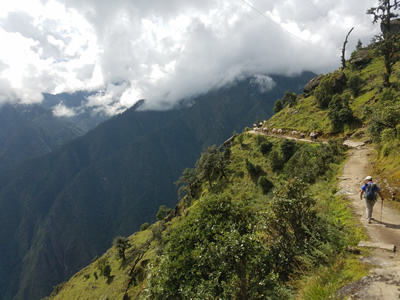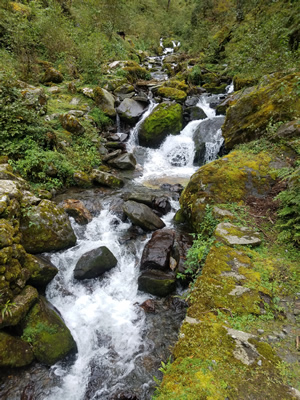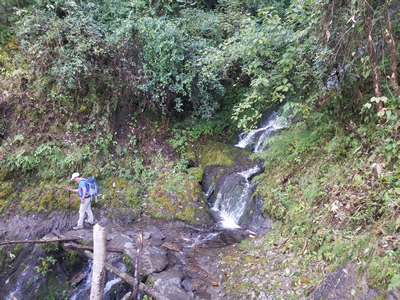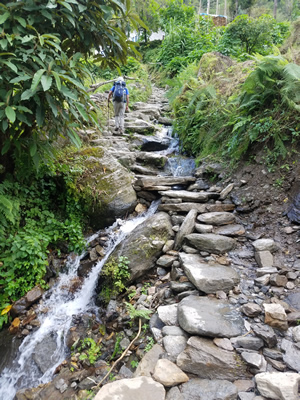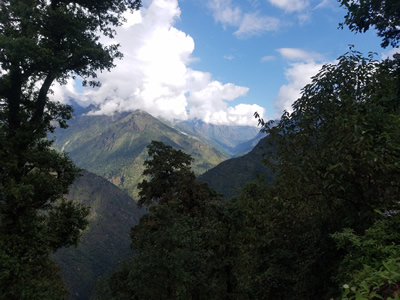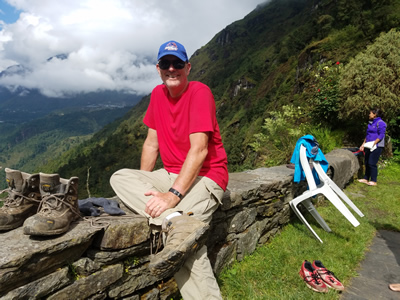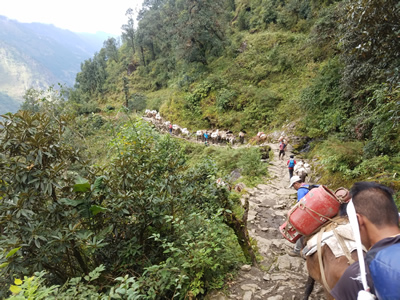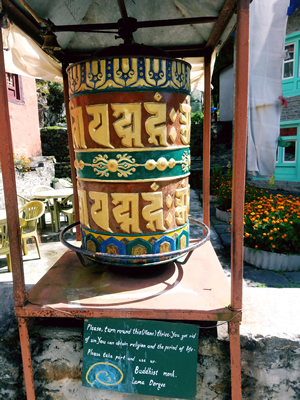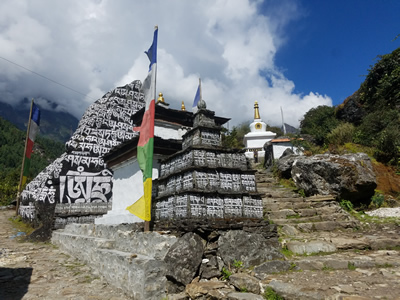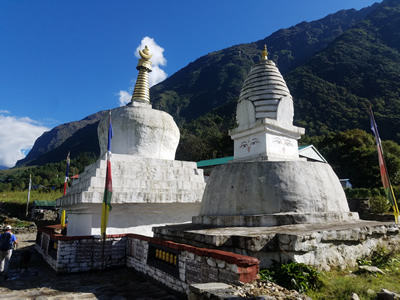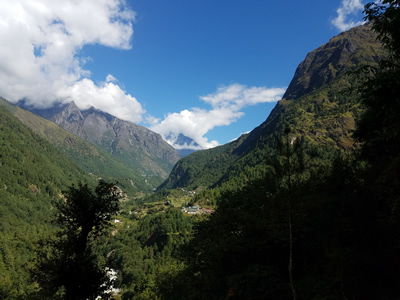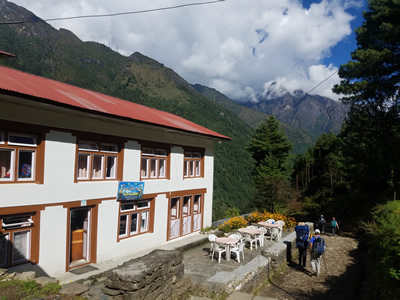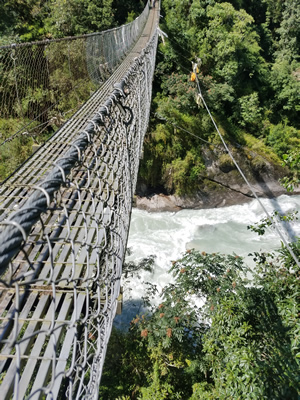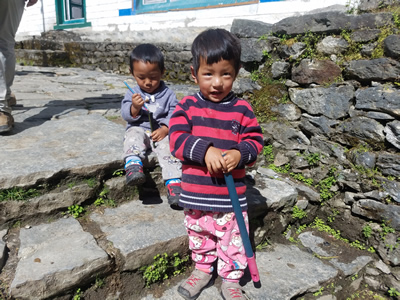Nepal pt5: Back on Track
In a third world country, there is always the risk that you will get sick. Sanitation is often poor and health practices can be nonexistant. It's easy to get GI tract problems from contaminated food or water. While usually not dangerous it can certainly be unpleasant. That's why I try to be careful about what I eat when I travel. I always go to see a doctor before my trip to get a prescription for an antibiotic to take with me. That way if I do get sick, I can take something for it immediatly.
Over the years I haven't had much trouble. I made three previous three trips to Nepal and only got sick once. It was on my very first trip, way back in 1990. I took the Cipro that I carried with me and was better the very next day. So based on my experience I usually don't worry about it too much.
That's probably why I got complacent. One of my rules is - don't eat any dairy products unless they are well cooked (like cheese on a pizza). But on the second night of the trek my spaghetti was served with grated cheese on it. Not wanting to make a fuss I just ate it. Sure enough, that evening I had mild diarrhea.
I took the antibiotic that I had with me. In the old days you would get a whole bottle. To help prevent bacteria from developing immunity to the antibiotic, you had to take it for about two weeks to make sure that all the bacteria were killed off. Now the approach is to give you a triple antibiotic. The idea is that even if a mutation develops to provide immunity to one of the antibiotics, the other two will still get the little buggers. So immune strains are never able to develop. It meant that just one shot would be enough if my symptoms went away. I also took a double dose of Imodium, which is the brand name for Loperamide, an over the counter anti-diarrhea drug. That had the potential to cause other problems later on because it can really plug you up, but for now I was focused on resolving my current issue. I didn't really feel sick or anything. I was just nervous because when you are on the trail you can't always find a bathroom quickly.
I slept through the night with no problems so that was a good sign. I felt good. At breakfast though I didn't want to take any chances. I didn't have anything to eat. I wanted to give my insides a chance to rest and recover. Shambu was worried about me. I guess he thought I might fade away to nothing or something. I don't normally eat breakfast anyway so it was no big deal for me. But acute mountain sickness can be a real problem in the Himalaya so trekking guides are always on the alert for it. And loss of appetite is one of the very first symptoms.
There had been a storm the night before and now the morning was overcast and humid. It looked like it might rain but fortunately we didn't get any, that day or for the rest of the trek. In fact some blue sky came out later for part of the day.
We started off with...you guessed it...a long uphill section. It took us about two hours to climb. It was frustrating. In mountaineering there is something called a false summit. It's a point that from below looks like the top of the mountain. When you reach it, thinking that you are done, you are disappointed to see that the true summit of the mountain is actually much higher and much farther away. I had the same experience on the trail this morning. The trail would traverse around a hillside. As I approached a corner I would be sure that it was the end of the uphill section and we would top out. As soon as I got there and could see around the corner, the trail would continue on up till it went out of sight around the next corner. Surely that would be where the trail leveled out. Except that this happened three or four times.
We stopped once for tea. Shambu was hoping to feed me some cookies with tea to make up for my skipping breakfast. I didn't like the looks of the place though so I didn't have anything. It was the only place that we stopped on the whole trek that I felt that way. Maybe I was just paranoid after the night before. I felt fine and was going strong though so I wasn't worried.
When we stopped for lunch it was a very nice place. It had an impressive view although the clouds had come back. The valleys were clear but the mountain tops were all in the clouds. At least it wasn't raining so I was good with it.
I still wasn't feeling hungry so I didn't want to take any chances with lunch. I skipped eating again. Shambu started fretting so I had to remind him that he was a trekking guide, not my mother, and that I was a Big Boy. He grumbled a little but didn't bug me any more. Because of all the activity on a trek, most people probably eat twice what they eat normally rather than less. I'll be the first to admit that I'm weird because I don't have much appetite when I am doing hard hiking.
After lunch we finally had a long, descending traverse that was pretty easy going. Except for the fact that we were stuck in the middle of the mother of all pack trains. Or maybe it was multiple pack trains, one after the other. I have no idea how many donkeys there were but it seemed like they were passing us for hours. Instead of admiring the view my eyes were on the trail, making sure that I didn't step in anything that the donkeys left behind. And I was really getting tired of smelling donkey shit, all the time.
We were getting close to Lukla. There were a lot of planes flying up the valley on their way there. Finally we came around a corner and we could see it, only a few miles away. We took a rest break and spent some time watching planes approaching and landing there.
Up to this point I did not have cell service. Sandy has set me up with AT&T international access before I left on my trip. While I was in Kathmandu it worked fine and I was able to check in with her. As soon as I went into the hills though I had zero bars. Shambu had a local carrier and he had cell service the entire time. Not me though. I had nothing. Nada. Then as soon as I came around the corner and could see Lukla, my phone jumped up to three or four bars. Cell phones are line of sight, after all and it's not surprising that if I would get cell service anywhere, it would be where there was an airstrip. While we were stopped for our break I had Shambu take my picture. I sent it to Sandy along with some text messages to let her know I was still alive and trekking.
We continued on to the village of Surke, where we spent the night. It was below Lukla so I lost line of sight and my cell signal with it. When we reached our lodge there was one other trekker there and I spent some time talking to him. He was a young Canadian from Kelowna named Thomas who was on his first trip to Nepal. He was on his way to climb Island Peak, a twenty thousand foot mountain near Mt. Everest that is not too difficult. I was envious. I would love to have a chance to climb it. Later some people he knew came by so he went on with them. For another night, we had the lodge all to ourselves again.
This lodge was not as nice as the last one. It wasn't as new or quite as clean and didn't have a flush toilet. But I had felt good all day so I decided that I would risk eating dinner. Everything was just fine. In fact (spoiler alert) I didn't have any more stomach issues for the rest of the trip. So it turned out it really hadn't been that bad.
The clouds that had been building up all afternoon turned into an impressive thunderstorm that night. There was a lot of thunder and lightning and for about an hour the rain really poured down. I didn't mind rain at night and by morning the weather had cleared. We got another early start. We were ready to rock and roll at 6:45 am, after I had eaten breakfast so Shambu was happy.
It took us about an hour of climbing to reach the junction with the trail descending from Lukla. Up to this point there had been few trekkers. Most of the traffic on the trails was local villagers or pack trains carrying supplies up to higher villages, mostly for businesses that served foreign tourists. Although there are no roads in the Khumbu region, it's not an uninhabited wilderness. There are a hundred thousand people who live there and everything moves by trail. Unlike the US, the trails are not there just for recreational use. They are the routes for people to travel and for all commerce to be done. Not only are there no motorized vehicles, the paths are so rough that there aren't even carts of any kind. People walk from place to place. Everything is carried either by people or animals. It's a step back to a much earlier time. Well, except that they have cell phone service.
Now there were a lot of foreigners on the trail who had just flown into Lukla. From that point on things changed dramatically. The few trekkers before Lukla were like me, traveling in small groups, only one or two foreigners. Now a lot of them traveled in packs. They were with large groups of ten or fifteen trekkers organized by adventure travel companies like Mountain Travel Sobek or REI Adventures. I have nothing against those companies. Sandy and I have done trips with both of them. It can be a lot of fun meeting people who share an interest in travel and getting to know them over the course of a trip. But it's a much different experience than the solo trekking I was doing now. I would see a large group of people hiking together, often with one Sherpa guide at the front and one at the back to herd them along and keep the group together. I was free to start when I wanted, stop when I wanted, and go where I wanted, at my own pace.
The dress code had definitely changed as well. Before Lukla the traffic on the trail was mostly local villagers who wore a mixtue of modern gear and traditional Nepali or Sherpa clothes. Even the trekkers were a more motley crew. Most of them hiked from the road instead of flying into Lukla because they were traveling on the cheap and they had a kind of hippie look about them. Now everyone was all North Face and Patagonia. They looked like they had just stepped out of an REI catalog.
But just because everyone was dressed like world-class mountaineers didn't mean that they were hard core hikers. (TRIGGER WARNING: the rest of this paragraph contains fat shaming) There were quite a few people who were overweight or who looked pretty soft. Some of them were out of breath and struggling whenever they encountered a short uphill stretch of trail. I even saw one guy who completely freaked out the first time that he had to cross one of the high suspension bridges over a river. One of the guides literally had to lead him by the hand to get him across and it took forever. Because the bridge was narrow everyone going both ways had to wait until he made it to the other side. This was going to be a major problem because there are probably a dozen of those bridges that have to be crossed every day along the route. Whatever that trekking guide was being paid, it wasn't enough.
For a lot of those people, it was going to be a looooooong walk to Mt. Everest.
Now that we had joined the main trekking route, even the trail itself was different. It was wider, well graded and not nearly as rocky. We were on the Everest Expressway. Of course we were still in Nepal so there were a lot of ups and downs, but the walking was certainly easier.
There were other changes that were definitely for the better. Something that had bothered me before had been how much trash there was along the trail. (Don't even get me started about Kathmandu, where there is garbage everywhere.) We are trained in the US to be conscious about litter, to understand that it spoils the landscape, and to take personal responsibility for our own trash. At least that's how my parents brought me up. The culture in Nepal is different and people there just don't seem to have the same concern. One example is a small event that happened on one of the first few days of the trek that really sticks in my memory.
We had just taken a break at a teahouse where Shambu and I each got a small pack of cookies. When he opened his, Shambu just threw the wrapper on the ground. My eyes bugged out. That would be unthinkable in the US in the mountains. But not in Nepal, so although it was tough, I didn't say anything. It was his country after all and I was a guest. But when we started hiking again, I did pick up his wrapper sureptitiously and took it with me to throw in the trash later.
To be fair, it's more difficult to be neat in remote mountain areas in the Himalaya. Once a week a big truck comes by my house to pick up the trash. That's not the case in hill villages in Nepal so getting rid of garbage responsibly is more of a challenge. Which is probably why there were rarely bins where you could throw your trash. The people in the villages didn't really want to have to worry about getting rid of it either.
After passing Lukla there were public trash barrels in most villages. Shops and lodges had waste baskets. Sometimes even in the middle of nowhere there were garbage bins alongside the trail. People must have spent a lot of time and effort working to keep the trails clean because there wasn't the trash that I had seen earlier in the trip. That was definitely a good effect of the foreign tourism.
Probably the biggest benefit though was that the villages all seemed much more prosperous. Buildings were newer, cleaner, better maintained and generallly nicer. Nepal is a poor country and has very few natural resources. Tourism is one of the few major industries and foreign tourists bring a lot of money into the country. The Khumbu region certainly has benefited. Individual Nepalis seemed to be doing much better too. They wore more (high quality) western clothing and much better footgear. All the villages had electricity and some houses even had satellite tv antennas. And as mentioned earlier, everyone seemed to have a cell phone. It was still primitive though. Most of them were (gasp!) flip phones.
As we hiked along we were just part of the crowd now, heading up the valley of the Dudh Khosi river. It was a nice, sunny day which made for good photos. The deep green of the hills and valleys contrasted with the bright blue sky and the white, puffy clouds that covered the tops of the high mountains. This section of the route was fairly easy, the trail staying near the river with no major ups and downs.
In the village of Chheplung we passed a major Buddhist shrine. There were many impressive mani stones. Some were huge boulders completely covered with inscriptions written in Sanskrit, the ancient Indian language used for the scriptures of Hinduism and Buddhism. Others were entire walls made up of individually painted stones. There were two large white stupas, one decorated with the eyes of the Buddha. There were many prayer wheels along the trail, with handles that made them easy to spin them as you passed. When they turn it is supposed to help you focus on the mantra written on the wheel and bring you closer to enlightenment. Even if you do not concentrate, just spinning the wheel brings you benefit. It is essentially like you chanted the prayer yourself. Because it is somewhat mechanical, it is important to spin the wheel clockwise and to always pass the mani walls on the left. Doing it the other way produces a negative, rather than a positive effect. No one needs bad karma.
We stopped for lunch in Phakding. It's only an easy half day of walking from Lukla but it's where most people who fly in stop to spend the night. That way they only have a short day of hiking after their flight. It also gives them a night to acclimatize to the altitude before climbing higher on the next day when they go to Namche Bazaar. According to our original schedule, we should have been here on October 1, when we were supposed to fly to Lukla. But we lost a day due to our flight being cancelled. It took us another full day to drive to the end of the road. And now after four days of trekking, we were in Phakding at midday on October 6. Since I was acclimatized we would continue on to the village of Monju to spend the night. But it was a big climb to Namche so we wouldn't go any farther than that the next day. We were finally back on the itinerary for our trek but had lost five full days. We would have to delete something higher up since we would have less time there now. But it was ok. The approach hike, the bus ride, even the chaotic day at the airport had all been a great adventure. Even though the rest of the trek would be beautiful, I was just on the standard tour now.
